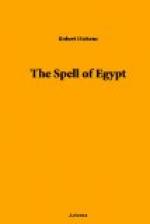Near Cairo, although the desert is real desert, it does not give, to me, at any rate, the immense impression of naked sterility, of almost brassy, sun-baked fierceness, which often strikes one in the Sahara to the south of Algeria, where at midday one sometimes has a feeling of being lost upon a waste of metal, gleaming, angry, tigerish in color. Here, in Egypt, both the people and the desert seem gentler, safer, more amiable. Yet these tombs of Sakkara are hidden in a desolation of the sands, peculiarly blanched and mournful; and as you wander from tomb to tomb, descending and ascending, stealing through great galleries beneath the sands, creeping through tubes of stone, crouching almost on hands and knees in the sultry chambers of the dead, the awfulness of the passing away of dynasties and of race comes, like a cloud, upon your spirit. But this cloud lifts and floats from you in the cheerful tomb of Thi, that royal councillor, that scribe and confidant, whose life must have been passed in a round of serene activities, amid a sneering, though doubtless admiring, population.
Into this tomb of white, vivacious figures, gay almost, though never wholly frivolous—for these men were full of purpose, full of an ardor that seduces even where it seems grotesque—I took with me a child of ten called Ali, from the village of Kafiah; and as I looked from him to the walls around us, rather than the passing away of the races, I realized the persistence of type. For everywhere I saw the face of little Ali, with every feature exactly reproduced. Here he was bending over a sacrifice, leading a sacred bull, feeding geese from a cup, roasting a chicken, pulling a boat, carpentering, polishing, conducting a monkey for a walk, or merely sitting bolt upright and sneering. There were lines of little Alis with their hands held to their breasts, their faces in profile, their knees rigid, in the happy tomb of Thi; but he glanced at them unheeding, did not recognize his ancestors. And he did not care to penetrate into the tombs of Mera and Meri-Ra-ankh, into the Serapeum and the Mestaba of Ptah-hotep. Perhaps he was right. The Serapeum is grand in its vastness, with its long and high galleries and its mighty vaults containing the huge granite sarcophagi of the sacred bulls of Apis; Mera, red and white, welcomes you from an elevated niche benignly; Ptah-hotep, priest of the fifth dynasty, receives you, seated at a table that resembles a rake with long, yellow teeth standing on its handle, and drinking stiffly a cup of wine. You see upon the wall near by,




